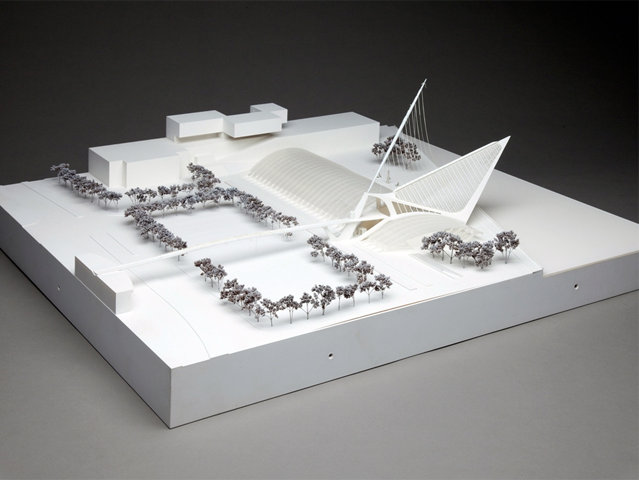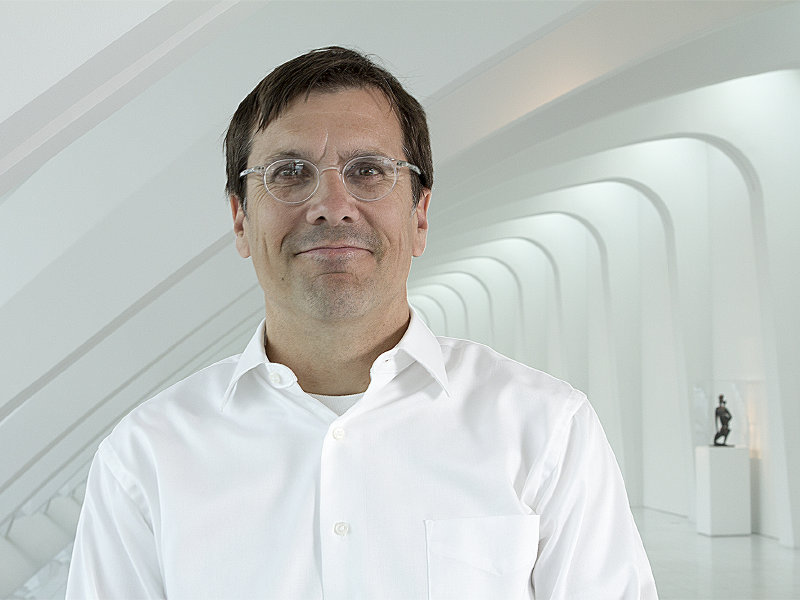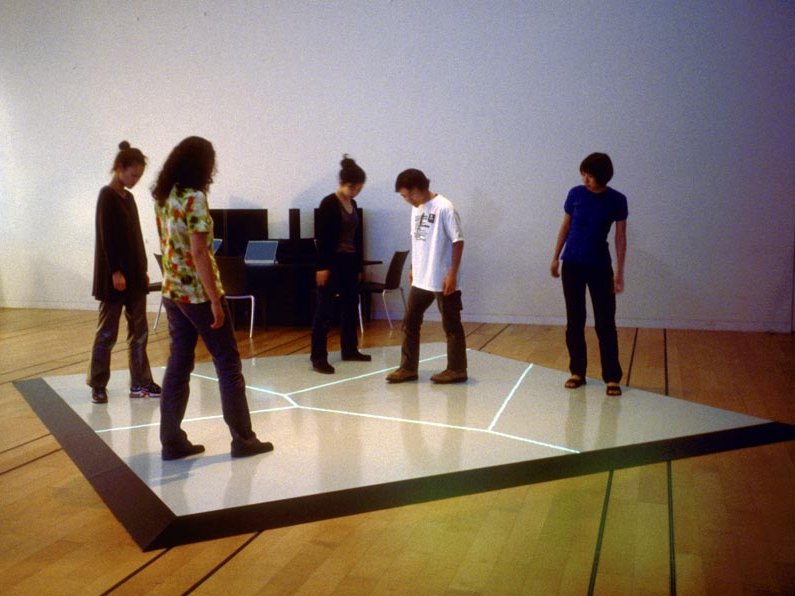On one hand, the fact that Santiago Calatrava's Quadracci Pavilion is 10 years old might seem hard to believe. It still looks so young, with nary a blemish, and it still feels so vibrantly alive.
Yet, over the course of a decade, and really from the get-go, the stark white, winged structure has become so synonymous with Milwaukee – both at home and abroad – that it's almost difficult to remember the city without it.
The structure has been called the sexiest building in the world and when it was built, Time Magazine called it the "Best Design of 2001." It's made it Hollywood via "Transformers" and was the most recognizable location in Milwaukee's "American Idol" moment.
Now, the Milwaukee Art Museum salutes its own building with a new exhibition that can be seen in the Koss Gallery and in the Baumgartner Galleria of the Calatrava wing.
"Building a Masterpiece: Santiago Calatrava and the Milwaukee Art Museum" opens Sept. 8 and closes on New Year's Day 2012.
"The exhibition features watercolors and models by the architect – works of art in themselves – that track the evolution of the building's design," says MAM's Chief Curator Brady Roberts. "The watercolors have a stream-of-consciousness-like quality, as the imagery flows from humans to sails, to Lake Michigan, to uncanny representations of Windhover Hall, imagined at the very outset of Calatrava's design process in the mid-1990s.
"His models reveal the complex development of the moving wings of the Burke Brise Soleil, one of the most spectacular architectural elements in the world."
You can see the models, which trace the evolution of the building in the galleria. The earliest is little more than a stylish swoosh, but one that clearly marks the genesis of the building.
"This to me is a successful abstract sculpture. It's a very beautiful thing," says Roberts, looking at the sculpture that pulses with movement. "It's an abstract streamlined sculpture, but the engineering, the counterbalance is already here.
"The basic forms are here. This doesn't look like anything you've ever seen before. So, you can imagine. It has a unique appearance. This generated a huge amount of excitement."
Other models show how recognizable features of the building changed both before and after Calatrava's design went public in 1996.
"The basic forms are coming together," says Roberts, pointing out first to a model from before the brise soleil (or wings) was added, and then to another that showed other noticeable differences from the completed structure.
"But (the building) is nowhere near as elegant as the final conception yet."
Upstairs in the Koss Gallery, located in the 1950s Eero Saarinen War Memorial section of the museum, there are watercolors that show not only the progression of the building's design, but Calatrava's artistic sensibilities, too.
There are roughly two dozen works on paper; works that Roberts called "small, discreet, very beautiful watercolors.
"He thinks as a painter, he thinks as a sculptor, he thinks as an engineer, all these things are synthesized in the way he operates and you can see that he has an affinity for early modernists when you look at his watercolors. He obviously likes Matisse and Cezanne, he uses brilliant colors.
"I read an interview with Calatrava a long time ago that asked what architects do you admire and he said, 'Well, I'm not going to answer the question the way you want me to but I have to say I really admire Cezanne because he would go and work at something and just continually, slowly building something up."
Back in the galleria, video monitors show photos of the building submitted by the public, a time lapse video of the construction of the building, engineering highlights and more.
Watching Calatrava's seed of the idea sprout and grow into one of Milwaukee's most iconic structures is fascinating. And it makes one reflect on the importance of the building to the Milwaukee psyche, but also to the image the building projects beyond Milwaukee.
"When I followed this building," recalls Roberts, who lived previously in Phoenix, "I thought, 'wow, that is a spectacular piece of architecture.' Then I came here and my suspicion was that the brilliance was going to wear off and after two and a half years, my appreciation has only grown. I still love being in the building and looking out through it and enjoying the architectural and sculptural forms. To me it's one of the most unique, fascinating buildings in the world. He's so original; it's not like anything else.
"I think it's one of those very rare buildings, like the Sydney Opera House, there are a handful of buildings like that in the world where the location becomes identified by that singular piece of architecture. The board set out to make an architectural statement. That was their mandate. So, A-plus on that one."
Born in Brooklyn, N.Y., where he lived until he was 17, Bobby received his BA-Mass Communications from UWM in 1989 and has lived in Walker's Point, Bay View, Enderis Park, South Milwaukee and on the East Side.
He has published three non-fiction books in Italy – including one about an event in Milwaukee history, which was published in the U.S. in autumn 2010. Four more books, all about Milwaukee, have been published by The History Press.
With his most recent band, The Yell Leaders, Bobby released four LPs and had a songs featured in episodes of TV's "Party of Five" and "Dawson's Creek," and films in Japan, South America and the U.S. The Yell Leaders were named the best unsigned band in their region by VH-1 as part of its Rock Across America 1998 Tour. Most recently, the band contributed tracks to a UK vinyl/CD tribute to the Redskins and collaborated on a track with Italian novelist Enrico Remmert.
He's produced three installments of the "OMCD" series of local music compilations for OnMilwaukee.com and in 2007 produced a CD of Italian music and poetry.
In 2005, he was awarded the City of Asti's (Italy) Journalism Prize for his work focusing on that area. He has also won awards from the Milwaukee Press Club.
He has be heard on 88Nine Radio Milwaukee talking about his "Urban Spelunking" series of stories, in that station's most popular podcast.







